Scaffolder – System ( 6 month course)
Scaffolder – System click here
Brief Job Description: Scaffolder – System is responsible for erecting, dismantling and
maintaining of various types of scaffold including system scaffold, staircase tower and
mobile tower scaffolds at specified heights. The individual should have good knowledge
of safe working practices and procedures while working at heights.
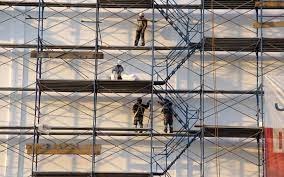
Personal Attributes: The individual is expected to be physically fit and should be able to
work across various locations and height withstanding extreme condition while working.
The individual should be organized, diligent, methodical and able to implement and
maintain safety practices. The individual should have independent ability to take quick
decisions and have good communication skills and shall be able to work within a team to
handle various scaffolding tools and materials and work responsibly for own work within
defined limit.
Description
Sector Sector is conglomeration of different business operations having similar
business and interests. It may also be defined as a distinct subset of the
economy whose components share similar characteristics and interests.
Sub‐Sector Sub‐Sector is derived from a further breakdown based on the characteristics
and interests of its components
Occupation Occupation is a set of job roles, which perform similar/related set of
functions in an industry
Job role Job role defines a unique set of functions that together form a unique
employment opportunity in an organization.
Occupational Standards
(OS)
OS specify the standards of performance an individual must achieve when
carrying out a function in the workplace, together with the knowledge and
understanding they need to meet the standard consistently. Occupational
Standards are applicable both in the Indian contexts.
Performance Criteria Performance Criteria are statements that together specify the standard of
performance required when carrying out a task.
Qualifications Pack (QP) Qualifications Pack comprises the set of OS, together with the educational,
training and other criteria required to perform a job role. A Qualification Pack
is assigned a unique qualification pack code
Qualification Pack Code Qualification Pack Code is a unique reference code that identifies a
qualifications pack.
National Occupational
Standards (NOS) NOS are Occupational Standards which apply uniquely in the Indian context.
Scope Scope is the set of statements specifying the range of variables that an
individual may have to deal with in carrying out the function which have a
critical impact on the quality of performance required.
Knowledge and
Understanding
Knowledge and Understanding are statements which together specify the
technical, generic, professional and organizational specific knowledge that an
individual needs in order to perform to the required standard
Organizational Context Organizational Context includes the way the organization is structured and
how it operates, including the extent of operative knowledge managers have
of their relevant areas of responsibility.
Technical Knowledge Technical Knowledge is the specific knowledge needed to accomplish specific
designated responsibilities.
Core Skills / Generic Skills Core Skills or Generic Skills are a group of skills that are key to learning and
working in today’s world. These skills are typically needed in any work
environment. In the context of the OS, these include communication related
skills that are applicable to most job roles.
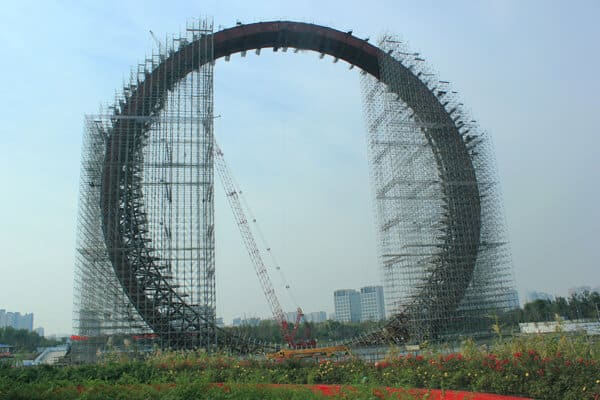
Keywords /Terms Description
CON Construction
NSQF National Skill Qualifications Framework
QP Qualification Pack
OS Occupational Standards
TBD To Be Decided
Erect and dismantle common customized system scaffolds
Description
This unit describes the skills and knowledge required to erect and dismantle common
system scaffold independently.
Scope
The scope covers the following:
Prepare work area for scaffold erection
Erect and alter customized system scaffolds(tube and coupler, frame
scaffold)
Dismantle the scaffold at a construction site
Performance Criteria (PC) w.r.t. the Scope
Element Performance Criteria
Prepare work area
for scaffold
erection
To be competent, the user / individual on the job must be able to:
PC1. determine the quantity of scaffolding material and component required for
erection based on type of scaffolds and height requirements
PC2. sort out all the components prior to erection of scaffold and
replace the damaged ones
PC3. check for and ensure level, compactness of ground by visual / physical checks
PC4. ensure all the required components, tools, equipment and material are
present prior to starting scaffolding work
PC5. check and fix guard rails and safety nets around the scaffold area to ensure
safe working conditions in case of already erected scaffold or while working
at heights
PC6. prevent unauthorized access to the work area by providing proper
barricades around the work area
Erect and alter common customized system scaffolds (tube and coupler, frame scaffold)
PC7. place base plates and sole boards on ground as per the marking for setting
the scaffolds
PC8. use proper components and follow erection with respect to types of scaffold
used as per standard practices
PC9. check verticality of scaffold at first level of erection and correct (if required)
before moving to the next level
PC10. check for rigidity and stability of scaffold
PC11. provide appropriate support to the scaffold erected as per standard practice
and instructions from superiors
PC12. fix walk boards, guard rail, toe boards and other components on the working
PC13. offer for scaffolding inspection , do any rework as suggested by inspector and
get it approve
Dismantle the scaffold
PC14. follow and ensure standard dismantling procedure according to types of
scaffold
PC15. check for stability, rigidity of scaffold before dismantling and maintain during
dismantling
PC16. remove guard rails, toe boards, walk boards and components sequentially
keeping the overall safety in mind
PC17. lower scaffold components in a safe manner following the proper laid down
procedure
PC18. clean, repair and store scaffold components for further use
Knowledge and Understanding (K)
A. Organizational Context (Knowledge of the company / organization and its processes)
The user/individual on the job needs to know and understand:
KA1. standard practices for scaffolding work
KA2. safety rules and regulation for handling and storing require scaffolding tools,
equipment and materials
KA3. personal protection including the use of relevant safety gears and equipment’s
KA4. service request procedures for tools, material and equipment
KA5. statutory compliance requirements related to working at height
B. Technical Knowledge
The user/individual on the job needs to know and understand:
KB1. sketches / schematic working drawing that may be required for setting /
erection of scaffolds
KB2. different types of scaffolds system such as pipe , couplers and other common
scaffold system (cup-lock system, peri, doka, layher ) and method of erection
KB3. basic principles of measurement and marking
KB4. how to select and use different components of scaffolds
KB5. types and usage of different scaffolding components as per the site
requirements
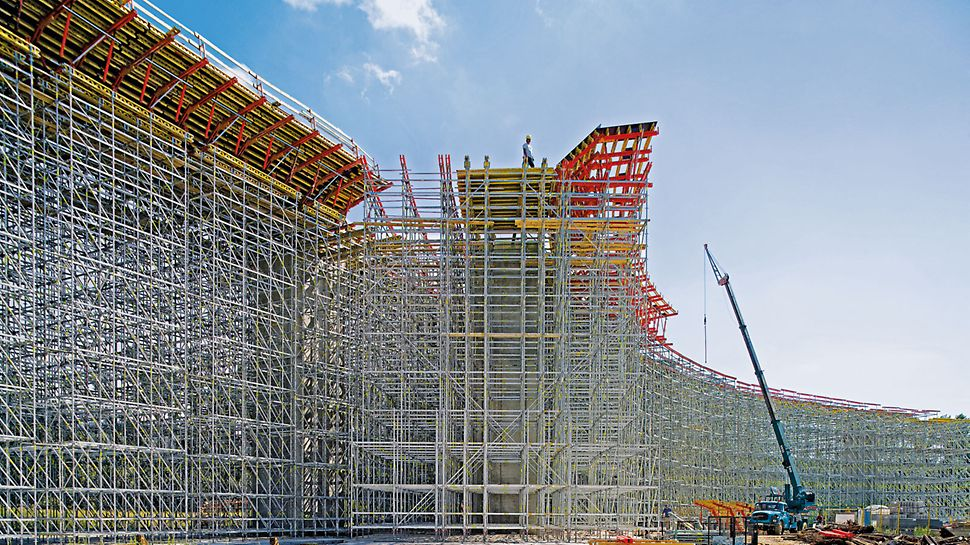
KB6. how to follow a methodical scaffolding plan as per the site requirements
KB7. maintenance of safe erection / dismantling of scaffolds
KB8. selection and use of various lifting devices
KB9. check and sort out all the related scaffolding components
KB10. identify and replace any damaged components
KB11. how to check and ensure alignment of scaffold
KB12. use of single and double pole scaffold
KB13. basic knowledge of formwork material
KB14. basic process of shuttering work
KB15. knowledge and understanding about loading
KB16. importance of getting scaffolding checked by inspector
Skills (S)
A. Core Skills/
Generic Skills
Writing Skills
The user/ individual on the job needs to know and understand how to:
SA1. write in one or more language, preferably the local language at the site
Reading Skills
The user/ individual on the job needs to know and understand how to:
SA2. read in one or more language, preferably the local language at the site
SA3. read sketches/drawing or instruction provided for the work
SA4. read instructions, guidelines, sign boards, safety rules ,safety tag and
instruction related to exit routes during emergencies at the work place
Oral Communication (Listening and Speaking skills)
The user/ individual on the job needs to know and understand how to:
SA5. speak in one or more language, preferably one of the local language at the site
SA6. listen and follow instructions given by the superior
B. Professional Skills
Decision Making
The user/individual on the job needs to know and understand how to:
SB1. decide whether his workplace is safe for working and also his work is not
creating hazardous conditions for other
Plan and Organize
The user/individual on the job needs to know and understand how to:
SB2. plan work and organize required resources in coordination with team
members and superiors
Customer centricity
The user/individual on the job needs to know and understand how to:
SB3. complete work as per agreed time schedule and quality
Problem solving
The user/individual on the job needs to know and understand how to:
SB4. rectify any problem in already erected scaffold
SB5. resolve any conflict within the team
Analytical Thinking
The user/ individual on the job needs to know and understand how to:
SB6. optimize resources
SB7. minimize wastage
SB8. revert to superior for selection/sorting of materials
Critical Thinking
The user/individual on the job needs to know and understand how to:
SB9. evaluate the complexity of the tasks to determine if any guidance is required from the superior
SB10. violation of any safety norms which may lead to accidents
Erect and dismantle staircase tower and mobile tower scaffold
Description
This unit describes the skills and knowledge required to erect and dismantle staircase
tower and mobile tower scaffold
Scope
The scope covers the following:
Erect staircase tower scaffold at construction site
Dismantle staircase tower scaffold at construction site
Erect mobile tower scaffold at construction site
Dismantle mobile tower scaffold at construction site
Performance Criteria (PC) w.r.t. the Scope
Element Performance Criteria
Erect staircase in tower scaffold
To be competent, the user / individual on the job must be able to:
PC1. check for and ensure level and compactness of ground by visual / physical
check
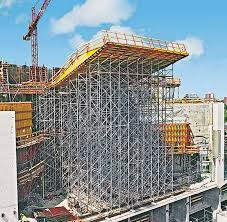
PC2. place base plates and sole boards on ground as per marking
PC3. follow erection procedure for staircase tower scaffold as per standard practice
PC4. check verticality of staircase tower scaffold at first level of erection and
correct before moving on to subsequent levels
PC5. check for rigidity and stability of staircase tower scaffold
PC6. provide support to staircase tower scaffold as per standard practice
PC7. fix guard rail, gap plates, kickboard and other related components on the
staircase scaffold
Dismantle staircase in tower scaffold
PC8. follow dismantling procedure as per standard practices
PC9. remove guard rails, gap plates, kickboards and components sequentially
PC10. check for stability, rigidity of scaffold before dismantling and maintain during
dismantling
PC11. lower staircase scaffold components in a safe manner
PC12. clean, repair and store staircase scaffold components for further use
Erect mobile tower scaffold
PC13. check for and ensure level, compactness of ground by visual / physical check
PC14. check for working conduction of castor wheel
PC15. follow erection procedure for mobile tower scaffold as per standard practice
PC16. check verticality of mobile tower scaffold at first level of erection and correct
before moving on to subsequent levels
PC17. check for rigidity and stability of mobile tower scaffold
PC18. provide support to mobile tower scaffold as per standard practices
PC19. fix walk boards, guard rail, toe boards and other components
PC20. unlock castors and move scaffold as per requirement
PC21. maintain prescribed distance from overhead power lines (if any)
Dismantle mobile tower scaffold
PC22. follow appropriate dismantling procedure as per standard practices
PC23. remove guard rails, toe boards, walk boards and components sequentially
PC24. check for stability, rigidity of scaffold before dismantling and maintain
during dismantling
PC25. lower mobile tower scaffold components in a safe manner
PC26. clean, repair and store mobile tower scaffold components for further use
Knowledge and Understanding (K)
A. Organizational
Context
(Knowledge of
the company /
organization and
its processes)
The user/individual on the job needs to know and understand:
KA1. standard practices for scaffolding work
KA2. safety rules and regulation for handling and storing require scaffolding tools,
equipment and materials
KA3. personal protection including the use of related safety gears and equipment’s
KA4. service request procedures for tools, material and equipment
KA5. statutory compliance requirements related to working at height
B. Technical
Knowledge
The user/individual on the job needs to know and understand:
KB1. standard procedure for erection, altering and dismantling of tower scaffolds
and staircases
KB2. methods and sequence of loading, unloading and shifting of scaffolding
components
KB3. sketches / schematic working drawing that may be required for setting /
erection of scaffolds
KB4. basic principles of measurement and marking
KB5. how to select and use components of scaffolds along with the related tools
and equipment’s
KB6. basics of various types of staircase and mobile towers along with the
components details and erection procedures as per the standards practices
including the following:
internal access towers – using working decks, bracing elements and
access decks (made of steel, aluminum, plywood or any of the
combination)

platform stairs / towers – made of aluminum to construct a landing
type stair tower using standard components
compact stair tower – used for compact spaces such as stairwells using
construction made of standard components (standards, ledgers and
decks) along with other components like (stairway stringers, deck
locking clamps and handrails)
modular stairs – using single stair components
allround stairway tower –suitable for stair access in public areas and
escape stair towers made using standard components (standards, ledgers and decks) along with other components like (stairway stringers, deck locking clamps and handrails), height can be adjusted
and stair width can be varied using different decks for treads as per the requirements.
KB7. how to follow a methodical scaffolding plan as per the site requirements
KB8. identify and replace any damaged components before setting or erection of
scaffolds
Skills (S)
A. Core Skills/
Generic Skills
Writing Skills
The user/ individual on the job needs to know and understand how to:
SA1. write in one or more language, preferably the local language at the site
Reading Skills
The user/ individual on the job needs to know and understand how to:
SA2. read in one or more language, preferably the local language at the site
SA3. read sketches or instruction provided for the work
SA4. read instructions, guidelines, sign boards, safety rules and safety tags at the
construction site
Oral Communication (Listening and Speaking skills)
The user/ individual on the job needs to know and understand how to:
SA5. speak in one or more language, preferably one of the local language at the
site
SA6. listen and follow instructions given by the superior on the appropriate process
to be followed
SA7. orally communicate to people from scaffolding trade on the surface
preparation, erection and dismantling procedure, mobility of tower, etc.
B. Professional Skills
Decision Making
The user/individual on the job needs to know and understand how to:
SB1. decide whether his workplace is safe for working and also his work is not
creating hazardous conditions for other
Plan and Organize
The user/individual on the job needs to know and understand how to:
SB2. plan work and organize require resource in coordination with team members
and superior
Customer centricity
The user/individual on the job needs to know and understand how to:
SB3. complete work as per agreed time schedule and quality
Problem solving
The user/individual on the job needs to know and understand how to:
SB4. rectify any problem in already erected scaffold
SB5. resolve any conflict within the team
Analytical Thinking
The user / individual on the job needs to know and understand how to:
SB6. erect staircase tower in and around obstruction or in case of any opening area
SB7. optimize resources
SB8. minimize resources
SB9. revert to superior for selection/sorting of materials
Critical Thinking
The user/individual on the job needs to know and understand how to:
SB10. evaluate the complexity of the tasks to determine if any guidance is
required from the seniors at the construction site
SB11. evaluate violation of any safety norms which may lead to accidents
Work effectively in a team to deliver desired results at the workplace
Description
This unit describes the skills and knowledge required to work effectively within a
team to achieve the desired results.
Scope
The scope covers the following:
Interact and communicate effectively with co-workers, superiors and subordinates across different teams
Support co-workers, superiors and sub-ordinates within the team and across
interfacing teams to ensure effective execution of assigned task
Performance Criteria (PC) w.r.t. the Scope
Element Performance Criteria
Interact and communicate in effective and conclusive manner
To be competent, the user / individual on the job must be able to:
PC1. pass on work related information/ requirement clearly to the team members
PC2. inform co-workers and superiors about any kind of deviations from work
PC3. address the problems effectively and report if required to immediate
supervisor appropriately
PC4. receive instructions clearly from superiors and respond effectively on same
PC5. communicate to team members/subordinates for appropriate work technique
and method
PC6. seek clarification and advice as per requirement and applicability
Support co-workers to execute project requirements
PC7. hand over the required material, tools tackles, equipment and work fronts
timely to interfacing teams
PC8. work together with co-workers in a synchronized manner
Knowledge and Understanding (K)
A. Organizational
Context
(Knowledge of
the company /
organization and
its processes)
The user/individual on the job needs to know and understand:
KA1. own roles and responsibilities
KA2. importance of effective communication and establishing strong working
relationships with co-workers
KA3. risks of a failure in teamwork in terms of effects on project outcomes,
timelines, safety at the construction site, etc.
KA4. different modes of communication, and its appropriate usage
KA5. importance of creating healthy and cooperative work environment among
the gangs of workers
B. Technical
Knowledge
The user/individual on the job needs to know and understand:
KB1. different activities within his work area where an interaction with other workers is required
KB2. applicable techniques of work, properties of materials used, tools and tackles
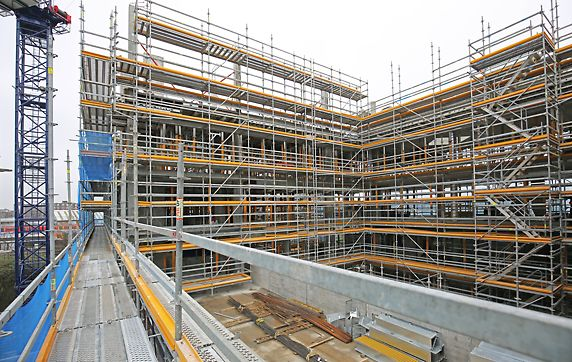
used, safety standards that co- workers might need as per the requirement
KB3. importance of proper and effective communication and the expected adverse
effects in case of failure relating to quality, timelines, safety, risks at the
construction project site
KB4. importance and need of supporting co-workers facing problems for smooth
functioning of work
Skills (S)
A. Core Skills/
Generic Skills
Writing Skills
The user/ individual on the job needs to know and understand how to:
SA1. write in one or more languages, preferably the local language at the site
Reading Skills
The user/ individual on the job needs to know and understand how to:
SA2. read in one or more languages, preferably the local language at the site
SA3. read communication from team members regarding work completed,
materials used, tools and tackles used, support required
Oral Communication (Listening and Speaking skills)
The user/ individual on the job needs to know and understand how to:
SA4. speak in one or more languages, preferably one of the local language at the
site
SA5. listen and follow instructions / communication shared by superiors/ co-
workers regarding team requirements or interfaces during work processes
SA6. orally communicate with co-workers regarding support required to complete
the respective work
B. Professional
Skills
Decision Making
The user/individual on the job needs to know and understand how to:
SB1. decide on what information is to be shared with co-workers within the team
or from interfacing gang of workers
Plan and Organise
The user/individual on the job needs to know and understand how to:
SB2. plan work and organize required resources in coordination with team
members
Customer centricity
The user/individual on the job needs to know and understand how to:
SB3. complete all assigned task in coordination with team members
Problem solving
The user/individual on the job needs to know and understand how to:
SB4. take initiative in resolving issues among co-workers or report the same to
superiors
Analytical Thinking
The user/individual on the job needs to know and understand how to:
SB5. ensure best ways of coordination among team members
SB6. communicate with co-workers considering their educational / social
background
Critical Thinking
The user/individual on the job needs to know and understand how to:
SB7. evaluate the complexity of task and determine if any guidance is required
from superiors
Plan and organize work to meet expected outcomes
Description
This unit describes the knowledge and the skills required for an individual to plan and
organize own work in order to meet expected outcome.
Scope
This scope covers the following:
Prioritize work activities to achieve desired results
Organize desired resources prior to commencement of work
Performance Criteria (PC) w.r.t. the Scope
Element Performance Criteria
Prioritize work
activities to achieve
desired results
To be competent, the user / individual on the job must be able to:
PC1. understand clearly the targets and timelines set by superiors
PC2. plan activities as per schedule and sequence
PC3. provide guidance to the subordinates to obtain desired outcome
PC4. plan housekeeping activities prior to and post completion of work
Organize desired
resources prior to
commencement of
work
PC5. list and arrange required resources prior to commencement of work
PC6. select and employ correct tools, tackles and equipment for completion of
desired work
PC7. complete the work with allocated resources
PC8. engage allocated manpower in an appropriate manner
PC9. use resources in an optimum manner to avoid any unnecessary wastage
PC10. employ tools, tackles and equipment with care to avoid damage to the same
PC11. organize work output, materials used, tools and tackles deployed,
PC12. processes adopted to be in line with the specified standards and instructions
Knowledge and Understanding (K)
A. Organizational
Context
(Knowledge of
the company /
organization and
its processes)
The user/individual on the job needs to know and understand:
KA1. importance of proper housekeeping
KA2. policies, procedures and work targets set by superiors
KA3. roles and responsibilities in executing the work for subordinates and self
B. Technical
Knowledge
The user/individual on the job needs to know and understand:
KB1. standard practices of work to be adopted for assigned task
KB2. how to use available resources in a judicious and appropriate manner to
minimize wastages or damage
Skills (S)
Writing Skills
The user/ individual on the job needs to know and understand how to:
SA1. write in one or more language, preferably the local language at the site
SA2. list out the assigned works and targets
Reading Skills
The user/ individual on the job needs to know and understand how to:
SA3. read in one or more language, preferably the local language at the site
SA4. read communication from co-workers, superiors and notices from other
departments as per requirement of the level
Oral Communication (Listening and Speaking skills)
The user/ individual on the job needs to know and understand how to:
SA5. speak in one or more language, preferably one of the local language at the site
SA6. listen and follow communication shared by co-workers regarding standard
work processes, resources available, timelines, etc.
SA7. communicate effectively with co-workers and subordinates
B. Professional
Skills
Decision Making
The user/individual on the job needs to know and understand how to:
SB1. decide on what sequence is to be adopted for execution of work
Plan and Organize
The user/individual on the job needs to know and understand how to:
SB2. plan and organize the materials, tools, tackles and equipment required to
execute the work
Customer centricity
The user/individual on the job needs to know and understand how to:
SB3. complete all assigned task with proper planning and organizing
Problem solving
The user/individual on the job needs to know and understand how to:
SB4. arrange or seek help to arrange for material, tools and tackles in case of
shortfall
Analytical Thinking
The user/individual on the job needs to know and understand how to:
SB5. analyze areas of work which could result in a delay of work, wastage of
material or damage to tools and tackles








